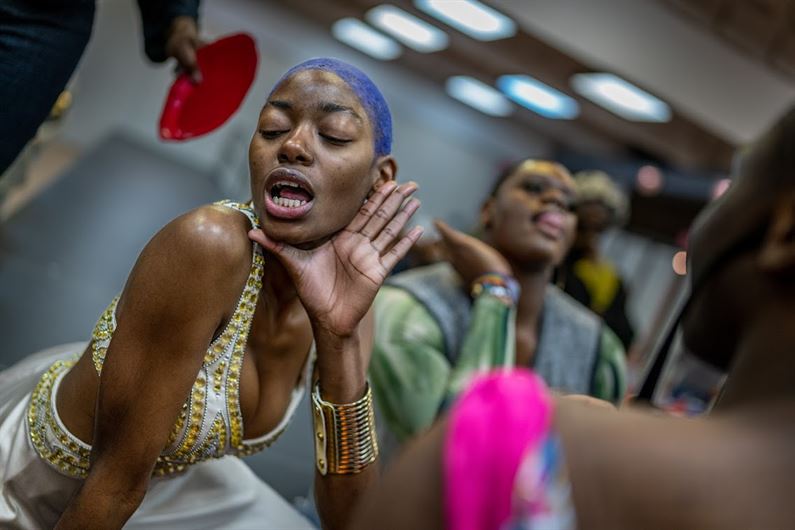Everyone wants a place they go to decompress. To feel free. To be liberated in a society where one often feels confined. On the night of Feb. 26, the Red Hawk Community Ball at Montclair State University was an embodiment of that.

A contestant performs during the "face" category Lynise Olivacce | The Montclrion
It was an infectious feeling of exhilaration. An environment that is an apt assessment of acceptance, inclusivity and vulnerability. Just the way you feel when you listen to Beyoncé’s latest album “Renaissance.” The Red Hawk Community Ball worked with the North Jersey Community Research Initiative (NJCRI), one of New Jersey’s largest and most comprehensive HIV/AIDS community-based organizations based in Newark, to help spread awareness.
The participants that night, Daughta Speaks, the first Black LGBTQIA+ organization on the Montclair State campus and second in New Jersey, and the Office of Social Justice and Diversity, were one of one, unique, and exceptional. It was too much Black excellence for one to handle. But if you missed it, I hate that for you.

Selah Piett, a junior dance major, competes in the performance category.
Lynise Olivacce | The Montclarion
The ball was a place to be accepted by someone and share this experience with someone who is like family. People who found each other in a hopeless place in a society that did not accept them were able to come together at this event. For others, it was a place where they began to see a different side of themselves to fully embrace.
The Ballroom Scene is a Latino and African-American LGBTQIA+ subculture that derives from New York City. It includes multiple categories where predominantly the LGBTQIA+ community competes to win trophies and prizes. But it’s all love because the competitors hug after they go against each other in different “houses.”
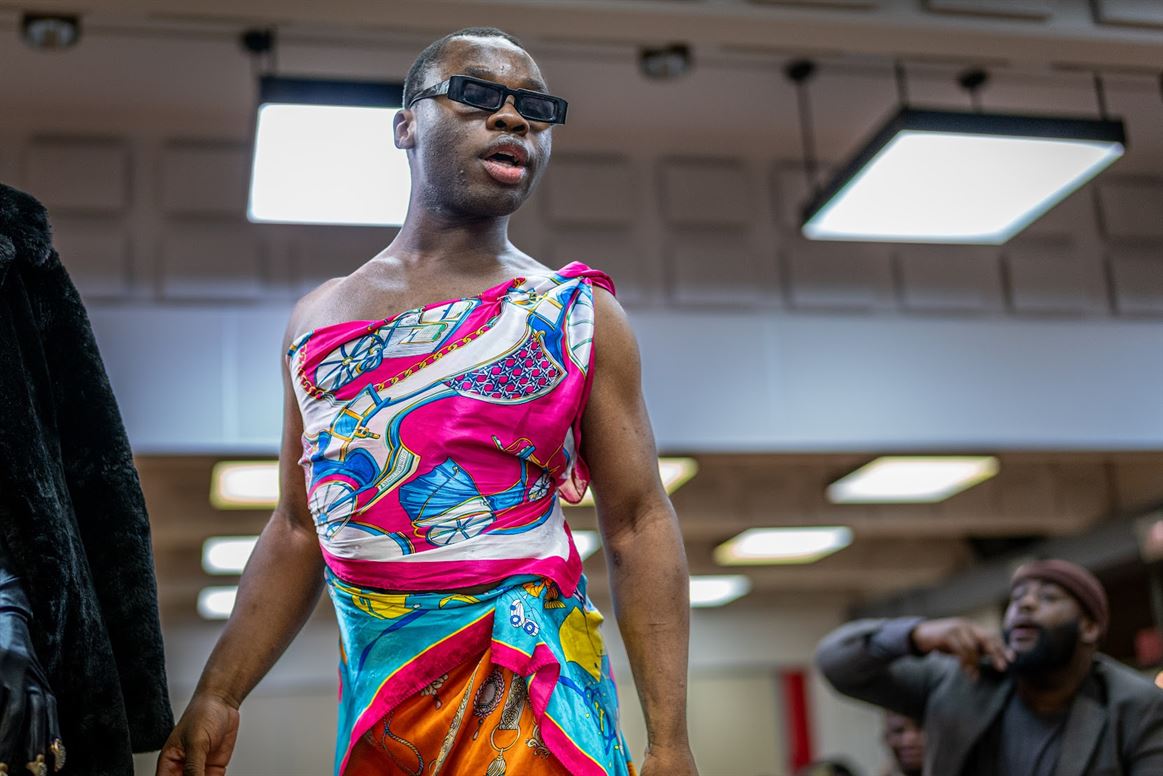
Tommiana, a junior fashion studies major, walks during the "best dressed" category.
Karsten Englander | The Montclarion
Along with a system of “houses,” which are chosen families, are the “fathers” and “mothers.” This community rejected Black homophobia and white supremacy, and its power was irresistible. It challenged systems of oppression and demanded freedom on the runway. People shouted “Mulan,” “Dior,” “Versace” and the names of the “Houses” each person was part of.
The other attendees of this event were the legendary “mothers,” “fathers” and “children,” from “houses” in New Jersey, in addition to the Queen of New Jersey, the Legendary Icon Hall of Famer and a Ballroom Scene liaison of New Jersey, Tyra Old Navy.
Each Ballroom category presented that night was “best dressed” led by Fame Dior, “runway” led by Killa Threadz, “realness” led by Shawn Bryant, “face” led by Yoncé Scott and “performance,” led by Gia Versace and Delilah Gabbana. The Ballroom Scene was created by transgender and queer people as a means of expression while being in a place of bondage, and also curated as a source of entertainment.
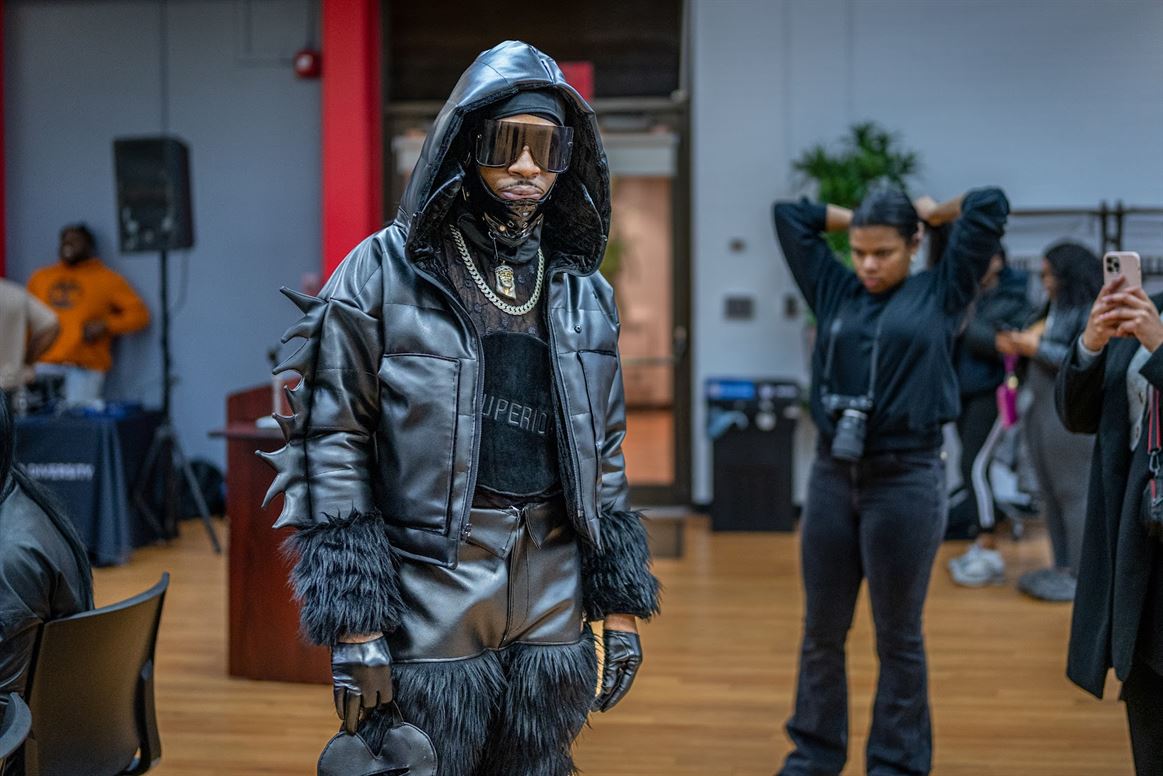
"Killa Threadz" poses for a photo after leading the "best dressed" category.
Karsten Englander | The Montclarion
“My purpose in coming here was to get the college kids in tune in Ballroom and explain what Ballroom is and get people to go out and expand their activities and talents,” Old Navy said. “So a lot of people have hidden talents that they are scared to come out. So we came to put on a show for them so they can get out of their comfort zone.”
It was a gratifying and hands-on educational experience for people to recognize the Ballroom Scene for what it is.
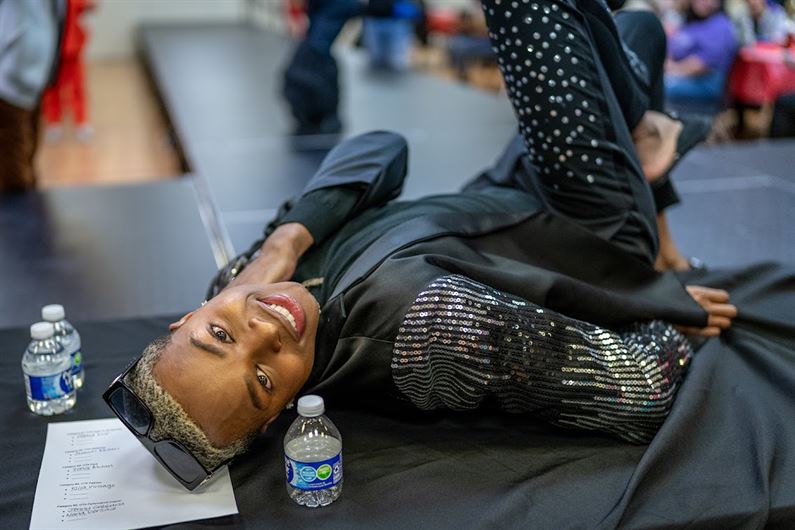
Yoncé Scott, who judged the "face" category poses for a photo.
Karsten Englander | The Montclarion
To be in a world where you are judged by the color of your skin, and how to express yourself through your sexuality, gender, and for gender non-conforming people, is something the Black LGBTQIA+ community had to go through and continuously do so in different aspects.
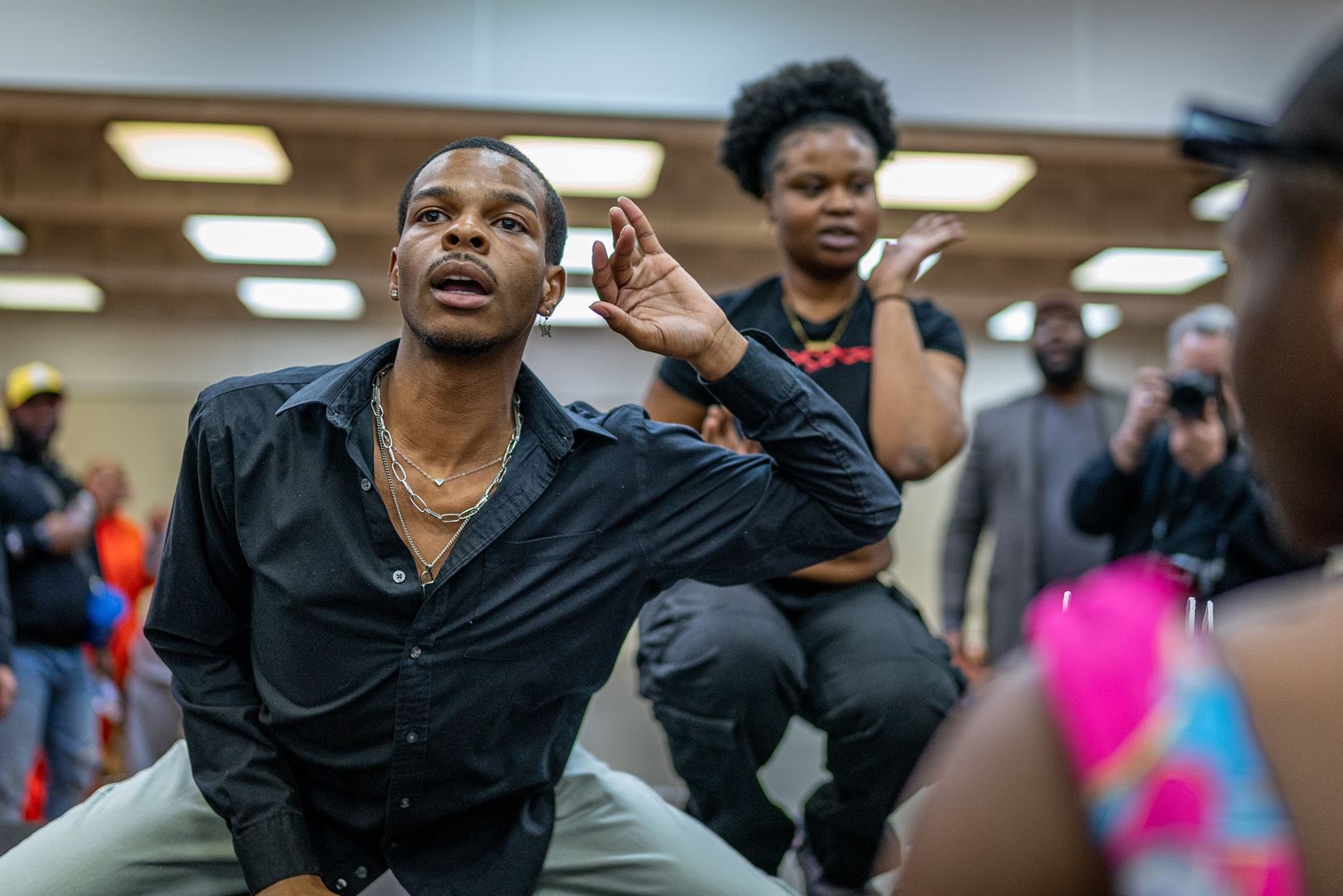
A contestant participates in the "face" category.
Karsten Englander | The Montclarion
The LGBTQIA+ community undoubtedly was historically unaccepted. It was a crime to come out, to a point where people were marginalized by immeasurable violence and prejudice. Therefore, it was something that took a toll on people and the community both mentally and physically.

Selah Piett, a junior dance major, and Na'Dree Stewart, a senior anthropology major, compete in the "performance" category.
Lynise Olivacce | The Montclarion
Even though this was a public event that was made for people to express themselves freely, it was acknowledged that people of this community were in clubs underground to escape from this harsh reality, and for some in their own households. This stigmatization led to the founders of special networks and cultural groups such as movements, creative collectives and the Ballroom Scene.

The judges judge during the "real" category.
Lynise Olivacce | The Montclarion
The pioneers of the Ballroom Scene walked so the attendees can run the runway. The judges that night were Tomiana, a junior fashion studies major, and the “fathers” and “mothers” of the “Houses.”

A’Lysai Robinson, a junior acting major, participates in the face category.
Lynise Olivacce | The Montclarion
The symmetrical features were serving looks as the judges were determining who will win “face.” Nonetheless, A’Lysai Robinson, a junior acting major, and Jade Denton, a sophomore psychology major, intensified the black girl magic on the runway as they were giving face, skin and structure.

Jade Denton, a sophomore psychology major, participates in the face category.
Lynise Olivacce | The Montclarion
“It was actually pretty liberating to participate in this event because even though I’m an actor, I’m not really a big person when it comes to Ballroom,” Robinson said. “Like I love watching it but having the opportunity to just participate in a space where I knew that I’d be accepted for who I am, as a beginner, with no experience. It feels liberating being able to just get up and have a good time.”

Na'Dree Stewart, a senior anthropology major and the president of Daughta Speaks, performs during the "performance" category.
Lynise Olivacce | The Montclarion
Denton said Ballroom is a safe space.
“It felt like home to me just because, I grew up being queer all my life,” Denton said. “But it’s a queer space for us. It’s a safe space. This is what I’m supposed to be doing, I’m alright.” [Ballroom Scene] is core level. It’s an art form. It is for everyone to come and show their true self.”

Evette Brown-Toney, a junior history major, competes in the "performance" category.
Lynise Olivacce | The Montclarion
Realness, in the words of Old Navy, the Queen of New Jersey herself, means, “mama can’t tell, papa can’t tell, grandma can’t even tell, when you walk up into any store, any hood. You are not getting clocked.”
She counted down to 10 as people rushed to the runway, and people pulled the audience to the stage.

Na'Dree Stewarts, the president of Daughta Speaks and a senior anthropology major, goes full out during the "performance" category.
Lynise Olivacce | The Montclarion
There are many forms of male figure realness, but that night they bought out a “pretty boy realness,” said Shawn Bryant, a New Jersey father from the House of Mulan. As he walked down the runway, the power of his look executed off the stage. Bryant was giving Lawrence Walker from “Insecure,” pretty boy eyes as he stared into the judge’s eyes.
“I just wanted to teach it to people about how ballroom is,” Bryant said. “Everybody can be part of it in some form or fashion. I like the confidence here. Everybody came out.”

Followed by the president of Daughta Speaks, Na’Dree Stewart, a senior anthropology major, did not disappoint. From “realness” to “performance,” he was able to change his demeanor and mannerisms with ease.
“I felt amazing and so liberating,” Stewart said. “Honestly, being that I won the performance category and this is the first time Montclair [State] has ever seen the Ballroom Scene come to Montclair State, in the form of like just voguing in the runway and all these different categories. This moment right here is liberating. We were able to put a whole new perspective on people’s life. It’s gag-worthy every time, every time and every time.”
As the night proceeded, the heat was turned up with the last category performance. The competition was fierce but Selah Piett, a junior dance major, ate and left no crumbs.
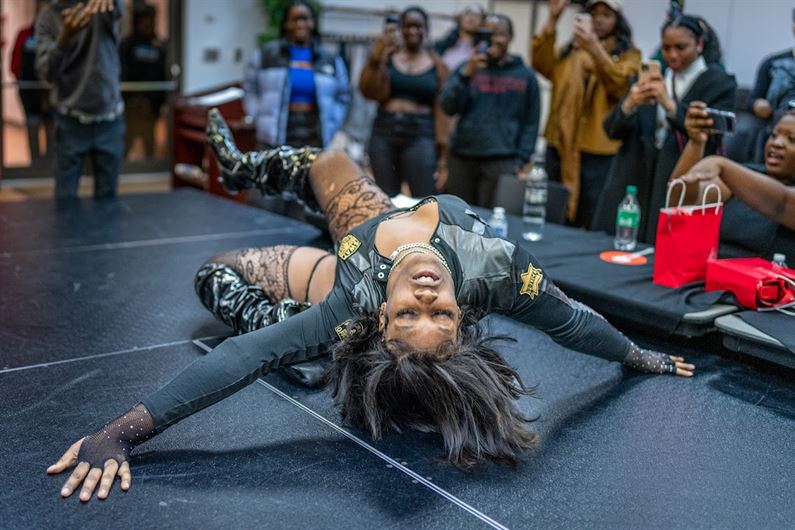
Delilah Gabbana, New Jersey mother of House of Gabbana struts down the runway before judging the performance category.
Karsten Englander | The Montclarion
Stewart wants the viewers to grasp from this event for them to always be authentic despite what people say.
“Always be authentically you,” Stewart said. “Walk in your truth and walk in whatever makes you feel comfortable. Because that’s how you’re going to make everyone else in the world comfortable and make [the] life we live [easy] because without everyone being themselves, they’ll be lost and nobody’s lost in Daughta Speaks. We all family and family aimed.”

Selah Piett, a junior dance major, performs in the dance category.
Lynise Olivacce | The Montclarion
Even though there is far more to go for the plights of the LGBTQIA+ community, the Ballroom Scene has taken part in the mainstream and bought representation further since it started. In the midst of a new golden age for Black culture and storytelling, a particular “Renaissance,” in the queer Black art and cultural representation is evident.
The attendees that night were unequivocally the embodiment of what the future pioneer dreamed of. They took the mic to defeat the animosity that clouded their light to shine from the past. The Community Ballroom that night clashes with the harsh past of the Black LGBTQIA+ community. The attendees defied societal standards unrepentantly and expressed the LGBTQIA+ community and Black culture.
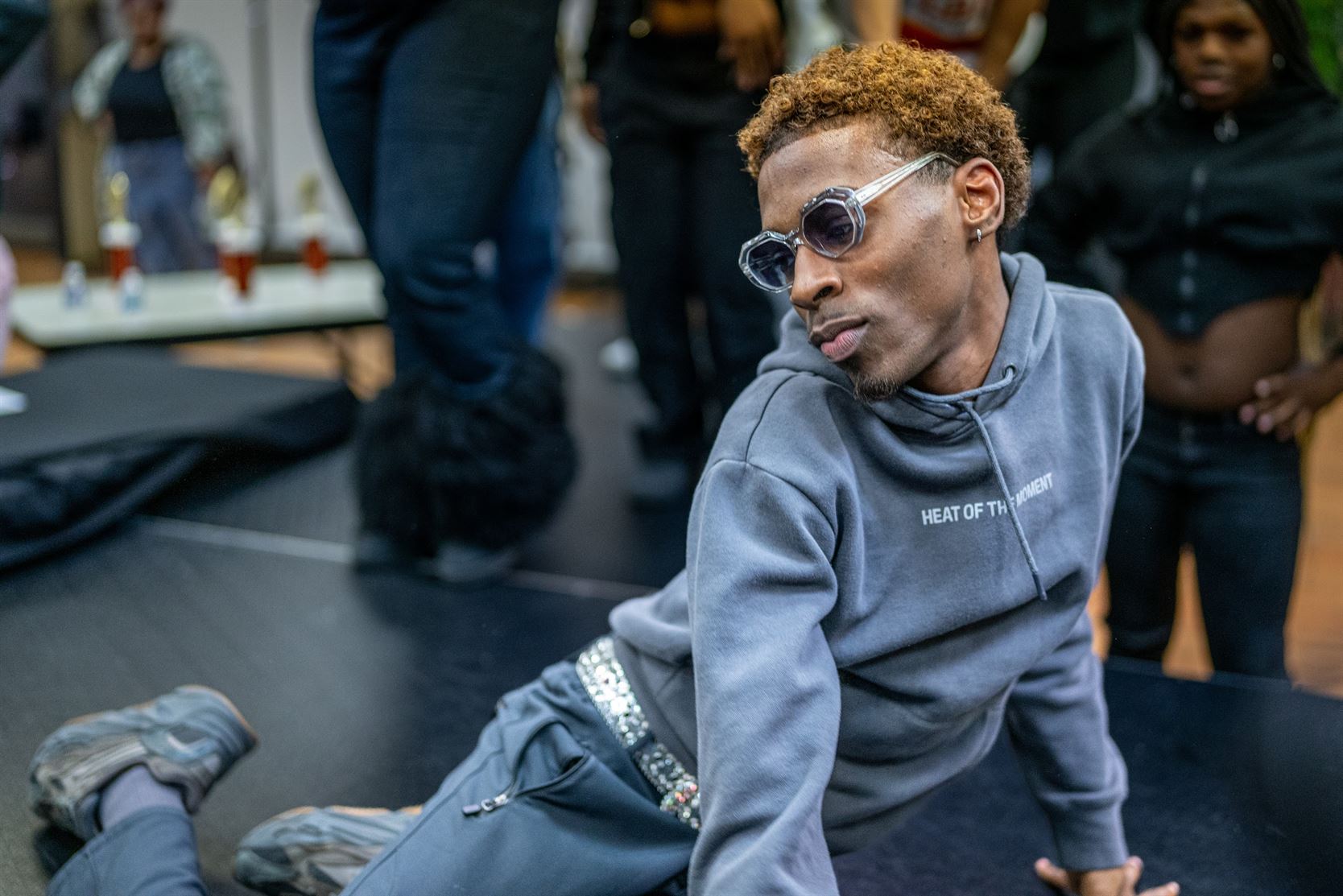
Na'Dree Stewart, a senior anthropology major and the president of Daughta Speaks, participates in the "performance" category.
Karsten Englander | The Montclarion
Everything that society dismissed they energetically embraced. The LGBTQIA+ community was able to have themselves reflected in their eyes, to be their own role model on the runway, their beauty marked the runway and glimmered from the painful history. It was important that night for those to see the beauty in their sass, and not allow society to dim their light and uniqueness to make others feel comfortable.
Stewart encourages all to attend Daughta Speaks meetings every Friday at 3:45 p.m. and to “remember to be the baddest of them all.”

